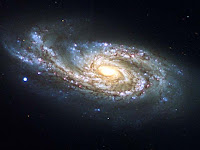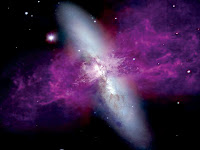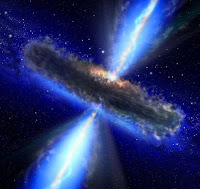
Galaxy:
Historically, galaxies have been categorized according to their apparent shape (usually referred to as their visual morphology). A common form is the elliptical galaxy, which has an ellipse shaped light profile. Spiral galaxies are disk shaped with dusty, curving arms. Galaxies with irregular or unusual shapes are known as peculiar galaxies, and typically result from disruption by the gravitational pull of neighboring galaxies.
 Such interactions between nearby galaxies, which may ultimately results in galaxy merging, may induce episodes of significantly increased star formation, producing what is called a star-burst galaxy. Small galaxy that lacks a coherent structure could also be referred to as irregular galaxies.
Such interactions between nearby galaxies, which may ultimately results in galaxy merging, may induce episodes of significantly increased star formation, producing what is called a star-burst galaxy. Small galaxy that lacks a coherent structure could also be referred to as irregular galaxies.
There are probably more than 100 billions galaxies in the observable universe. Most galaxies are 1`000 to 100`000 parsecs in diameter and are usually separated by distances on the order of millions of parsecs (or mega parsecs). Intergalactic space (the space between galaxies) is filled with a tenuous gas of an average density less than 1 atom/cubic meter . The majority of galaxies are organized into hierarchy of associations called clusters, which, in turn, can form larger groups called super-clusters. these larger structures are generally arranged into sheets and filaments, which
 surround immense voids in the universe. Although it is not well understood, dark matter appears to account for around 90% of the mass of most galaxies. observational data suggests super-massive black holes may exist at the center of many, if not all, galaxies. They are proposed to be the primary cause of active galactic nuclei found at the core of some galaxies. The milky way galaxy appears to harbor at least one such objects within its nucleus.
surround immense voids in the universe. Although it is not well understood, dark matter appears to account for around 90% of the mass of most galaxies. observational data suggests super-massive black holes may exist at the center of many, if not all, galaxies. They are proposed to be the primary cause of active galactic nuclei found at the core of some galaxies. The milky way galaxy appears to harbor at least one such objects within its nucleus.
The word galaxy derives from for the Greek term for our own galaxy, Galaxias(?a?a??a?), or kyklos galaktikos, meaning "Milky circle" for its appearance in the sky. In Greek mythology, Zeus places his son born by a mortal women, the infant Heracles, on Hera`s breast while she is asleep so that the baby will drink milk and will thus become immortal. Hera wakes up while breast feeding and then realizes she is nursing an unknown baby: she pushes the baby away and a jet of her milk spray the night sky, producing
 the faint band of light known as the milky way. In the astronomical literature, the capitalized word "Galaxy" is used to refer to our galaxy, the milky way, to distinguish it from the billions of other galaxies. The term milky way first appeared in the English language in a poem by Chaucer.
the faint band of light known as the milky way. In the astronomical literature, the capitalized word "Galaxy" is used to refer to our galaxy, the milky way, to distinguish it from the billions of other galaxies. The term milky way first appeared in the English language in a poem by Chaucer.
The Milky way:
On the Galactic center of Milky way and a meteor, the Greek philosopher Democritus (450-370B.C.) proposed that the bright band on the night sky known as the Milky way might consists of distant stars. Aristotle (384-322B.C.), however, believed the Milky way to be caused by "the ignition of the fiery exhalation of some stars which were large , numerous and close together" and that the "ignition takes place in the upper part of the
 atmosphere, in the region of the world which is continuous with the heavenly motions." The Arabian astronomer Alhazen (965-1037A.d.), refuted by making the first attempt at observing and measuring the Milky way`s parallax, and thus "determined that because the Milky way had no parallax, it was very remote from the earth and did not belong to the atmosphere. "
atmosphere, in the region of the world which is continuous with the heavenly motions." The Arabian astronomer Alhazen (965-1037A.d.), refuted by making the first attempt at observing and measuring the Milky way`s parallax, and thus "determined that because the Milky way had no parallax, it was very remote from the earth and did not belong to the atmosphere. "
No comments:
Post a Comment